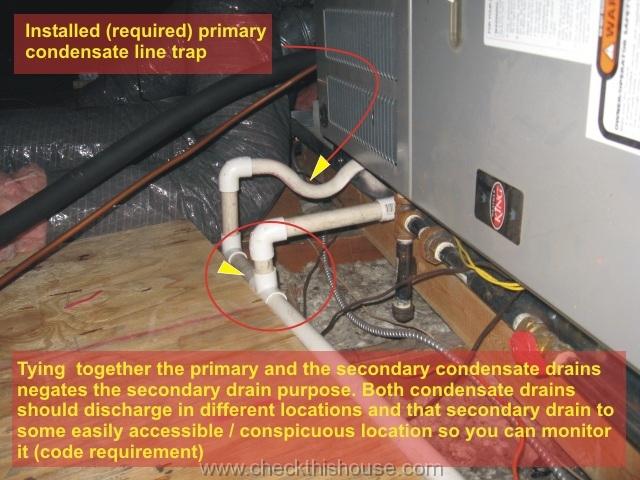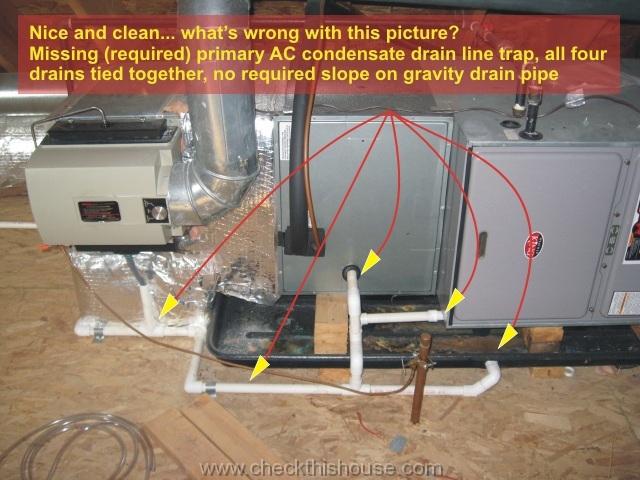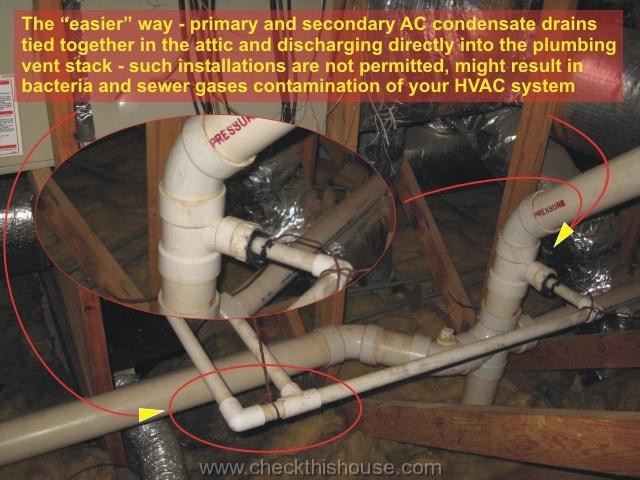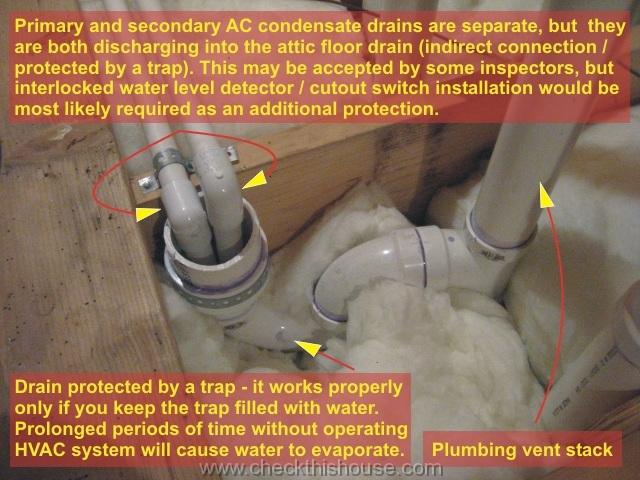Attic Air Conditioner Drip Pan Installation & HVAC Coil Catch Pan
Following industry standards apply to the attic air conditioner drip pan installation and locations where leaking condensate could damage building components.
Attic air conditioner drip pan installation falls under the IRC (International Residential Code) and UMC (uniform Mechanical Code) regulations.
Like with any building codes, check with your local building department if any or all of the following requirements apply in your jurisdiction. Even if you don’t like rules, make that attic air conditioner drip pan installation a part of your warm season house maintenance procedures before it will start leaking, and damage the ceiling.
The following industry standards apply to locations where accumulating / not draining properly condensate would damage building components, and the attic air conditioner drip pan installation fits right under those standards.
The rules listed below are based on 2006 IRC – International Residential Code [….], and 2006 UMC – Uniform Mechanical Code{….}:
Protection is required if condensate stoppage would damage building components[IRC] {UMC} :
Secondary AC condensate drain to a conspicuous point of disposal – you need to have a main drain from the coil catch pan located inside the coil compartment and a secondary drain in case the first one gets clogged [IRC] {UMC}.
Both AC condensate drains should discharge in different locations and that secondary drain to some easily accessible / conspicuous location so you can monitor it (code requirement). If you notice condensate dripping from the secondary discharge pipe, it means that the main condensate drain pipe stopped functioning for some reason.
The attic air conditioner drip pan installation installers are sometimes tying together both – the primary and the secondary drains, which installation negates the secondary drain purpose.
Just think for a moment, if the primary and the secondary pipe discharges in the attic, will you ever go there and check on them?
The areas that people install AC condensate secondary discharge pipe: above the kitchen window / through the roof soffit (not over or into the public way), sinks, toilet bowls (if you have some pictures and don’t mind emailing me them for posting online, please let me know).
Attic air conditioner drip pan installation options
- In case that auxiliary drip pan cannot be plumbed to some conspicuous location, it requires interlocked detector / cutout switch. The switch cuts off the power supply and stops air conditioning system operation as soon as the water starts accumulating inside the drip pan [IRC] – this is probably the most effective way of alerting the homeowner about the problem.
- In case the attic air conditioner drip pan installation isn’t possible at all, the IRC calls for water level detection device with interlocked cutout installed in AC coil primary drip pan.
This particular requirement also applies to the down-flow type units (blower motor installed on top / blowing down) with no secondary drain and no means of installing auxiliary drip pan
- Primary AC condensate discharge pipe requires a trap installation (no traps on a drip pan secondary line )
A central air conditioner condensate trap purpose is to prevent air from being discharged from or sucked back into the “A” coil compartment or air handler during system operation.
For the attic air conditioner drip pan installation, a missing trap on the primary AC condensate discharge pipe compromises system’s efficiency. It may also be responsible for condensate drainage problems, internal leaks, mold contamination of the coil compartment wall liner.
The next step in the attic air conditioner drip pan installation is to find a place to drain the primary discharge line and the secondary drip pan under the coil. This is often a challenge for HVAC contractors, especially when dealing with remodeling projects, additions, alterations of the existing property.
There are a few, constantly broken rules that apply to the attic air conditioner drip pan installation and the condensate discharge pipe / its terminations in general;

- AC condensate discharge pipe must be at least ¾” in diameter and the minimum required slope towards the drain should be 1/8”. This applies to gravity / natural drain with no condensate pump assistance. Make sure that there are no reductions in pipe diameter along the entire run. There’s always some dust, lint, corrosion that will eventually cause blockages, especially if a smaller size condensate line is being used.
- Types of materials that are permitted to be used as a condensate drain pipe: PVC, cast iron, galvanized steel, copper, polybutylene, polyethylene, ABS and CPVC.
- AC condensate shall not discharge over or into the public way: the sidewalk, stairs, etc. You should also avoid areas where condensate might affect / damage house finishes, cause site erosion, or penetrate foundation / cause foundation settlement.
- Dripping condensation will eventually stain / cause discoloration of concrete, stone, brick, siding (and other materials), and by keeping them moist promote mold growth on their surface. Also, you have to keep in mind that some of those AC condensate discharge pipes might be responsible for condensing / high efficiency furnace drainage. In such case, house exterior wall termination (and sometimes attic installation that is not protected / insulated) of the discharge pipe might freeze up in a cold climate. This will compromise high efficiency furnace operation and flood the heat exchanger.
- Direct connections of the AC condensate discharge pipe to plumbing system waste or vent pipe are not permitted. This is the most (at least from my experience) abused installation requirement. Because it is easy and much faster than trying to do it right (especially in the attic), many installers of the air conditioning system connect the condensate discharge pipe directly.
There are two very important concerns associated with a direct connection of the attic air conditioner’s condensate discharge pipe to the plumbing system waste or vent pipe;
- It makes difficult or in most cases impossible to early detect any blockages inside the “A” coil compartment.
- There is a possibility of bacteria growing back up the condensate line and / or sewer gases contamination of the air conditioning system
The attic air conditioner drip pan installation – recommended condensate discharge locations (it applies to any central AC system installation as well)
AC condensate might drain indirectly into the waste pipe – an example would be the tub overflow, the sink tailpiece, laundry drain. However, in all those examples, discharge pipe must be connected above the p-trap on the sink side, bathtub overflow side, laundry machine discharge pipe connection side – such connection is called “indirect” waste pipe connection.
Here are some of the other locations the AC condensate can discharge to, but under one condition – the lowest point of the condensation drain line must remain at least 2″ above the highest flood level rim of the indirect waste receptor;
What is that “indirect liquid waste receptor” – it is a plumbing fixture (like a sink) with a p-trap installed on its drain line that separates it from the sewer / waste system, and makes the connection indirect.
- Sinks – if it has a safety overflow, condensate discharge pipe must be at least 2” above it, without overflow hole – 2” above the sink edge
- Floor drains are acceptable for condensate discharge, but NOT directly into the ejector pump pit the floor drain is connected to
- Sump pump pit is also acceptable
- Trap in the attic attached to the vent stack – if you use it to drain the primary and the secondary condensate drain pipe, your local building inspector may not approve it.
However, it might work if combined with the water level detection device / interlocked cutout switch. Also, such drain will perform properly only if you keep the trap filled with water. Prolonged periods of time without operating HVAC system will cause water to evaporate and allow sewer gasses to discharge into the attic.
With the attic air conditioner drip pan installation, you can try to use the plumbing vent chase or other vertical space between the attic and the lowest level to drop the condensate carrying drain pipes down and discharge them to any of the listed locations. Just make sure that you seal the penetrations on both ends – at the attic floor and at the bottom – for example basement ceiling.
Very bad choices for the attic air conditioner drip pan installation and any other central AC systems condensate discharge pipe terminations;
- Crawlspace – dumping any moisture into the crawlspace is always a bad idea, moisture attracts all kinds of insects, can contribute to differential settling and facilitate the growth of a variety of molds that can promote unhealthy conditions
- Discharging under the concrete slab – I see such installations sporadically, usually in older homes/basements, and I can’t even imagine the bacteria/mold growing under the concrete layer and contaminating condensate discharge pipe.
So how is your attic air conditioner drip pan installation doing…










I understand the need for a p-trap on the primary drain line, but why don’t you need one on the secondary line (to drain pan with level float switch)? Wouldn’t this drain blow air without a trap?
Hi Graham,
That secondary drain line and pan are not under any kind of pressure, both fully open, so there’s nothing that would blow air into that drain line with or without the trap. On the contrary, one end of the primary condensate discharge line is fully enclosed by the coil compartment and pressurized at that end once the blower kicks in. Does that make sense…? Let me know.
Darek
Questions,
I am going to do a lot of the new attic location install of a heat pump and gas HVAC system. I have plenty of space and head room in the attic. Old HVAC closet too small for new high efficient units.
I think I have a good handle on the extra drip pan, drains, and gas pipe. I know from talking to people and info on the web there are requirements for a walkway to the platform and requirements for the platform. I have been unable to find any specific general requirements as to height, width, and work area. Most of the pictures I have seen do not show a place to stand next to the unit.
Do you have available a spec sheet that would address walkway and platform?
Hi Gale,
Sorry for a delay but I decided to answer your questions with a short article so more visitors can benefit from it. Here is the link https://checkthishouse.com/6209/attic-furnace-platform-installation-requirements.html
Let me know if this is sufficient and if I can help you with anything else.
I have two air conditions in the attic both are tied into one pipe that leads to the an upstairs bathroom drain, each air condition has a drip pan and each drip pan has it’s own pipe that leads to the outside of the house. My situation is that the drip pans are filling up and the water is dripping out of the pipes on the side of the house, and it seems that none of water is going through the one tied in pipe that lead to the upstarirs bathroom drain like should. I was told that the pipe was clogged and needed to be unclogged by blowing air through it. I had this done and it did not help the situation. Are my units installed correctly with this one pipe that lead to the drain or do I have another problem that requires more then just the pipes being unclogged with air being blown through them
Hi Derek,
I don’t know if your condensate drain tubing is correctly installed, you didn’t explain how it is connected to that drain, its slope, etc. Just compare your installation with the description in my post. If it is a direct connection to the plumbing drain – it is wrong. Blowing air through the condensate drain pipe sometimes helps but I would suggest to open the coil compartment (turn the AC blower power OFF prior to cleaning procedure) and clean the drip pan underneath the coil (and the coil). If it doesn’t drain (assuming that you can see the discharge end / no condensate dripping out of it) it is still clogged / becomes clogged right after you blow some air through it, or it could be improperly pitched.
Is the primary AC drip pan under the coil replaceable, OR you have to change the coil and the it’s pan at the same time? I am not talking about the secondary Pan.
Thank you.
Hi Zaven,
It depends on the design of the assembly. Older AC coil drip pans were metal and sometimes permanently attached / soldered to the coil itself. It might be possible to get the pan separated from the coil but I’m not sure if you can order a new one from the manufacturer. If it is a molded plastic drip pan, it’s usually secured to the coil brackets with screws, so it shouldn’t be a problem with taking it apart. Depending on the damage to the coil pan you may have another option; it’s a Drain Pan Repair Spray- http://bit.ly/b8welt , or this one – http://bit.ly/9D1jd2
Friend of mine is a HVAC contractor and he did use the first one a few times – he says it worked fine.
Are there any industry standards, or HVAC industry organizations, that call out the use of a drip pan in an attic installation? We do not have one installed in our attic. When I called the company who installed they said they never do that. Three other HVAC professionals have looked at it and asked why didn’t they install one. Just wondering what the industry standard is.
The post about the attic installed AC drip pan has been updated, let me know if you need more information